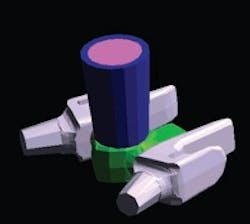Gate-and-runner systems have traditionally dominated in metalcasting operations, but the more recent development of direct-pour technology has provided a compelling alternative to older methods — one that cannot be ignored.
Direct-pour technology seems incredibly simple, at least from the foundry operator's standpoint. Basically, a direct-pouring unit consists of a cup with an integrated ceramic foam filter. Everything — from sprue to gate — is replaced by one condensed unit, approximately the size and shape of a riser sleeve, which circumvents many of the complications of conventional gating systems. And, it works.
All of the mechanisms between the pouring ladle and casting cavity are there to perform three basic functions: efficient metal delivery, inclusion removal, and regulating the stream of molten metal.
With conventional non-filtered methods, effective inclusion removal relies heavily on runner surfaces and fluid mechanic principles to separate non-metallics from liquid metal.
Traditional runner systems deliver molten metal to ingates that feed into the component casting. This process depends partly on the metal's passage through the runners themselves as a way to trap and remove contaminants prior to entering the casting — impurities are expected to float to the top and get sorted out by their adherence to runner walls, runner extensions, and other flotation- and flow-based mechanical means. Hopefully, too, the metal stream can be throttled and channeled such that it enters into the casting without turbulence. But sometimes, turbulence-related issues may arise within, and as, byproducts of the gate-and-runner system itself.
Another concern is that some contaminants become fluid at metal temperatures, making separation more problematic. Ceramic foam filters, placed inside the runners, have served well as an adjunct to some gate-and-runner systems, keeping out both solid and liquid impurities. In a typical runner system, the ceramic foam filter is placed along the runner rather than at the in-gate; thus, turbulence still may occur downstream of the filter. (Molten metal cools progressively as it passes along the runner system, and this generally precludes placing the filter right at the gate itself, although there are now specialized ceramic foam filters that address this and allow positioning at or near the in-gate.) In any case, the use of ceramic foam filters has helped, but the overall inelegance of gate-and-runner systems lingers.
Direct-pour performance is predicated on a predictable, well-contained filtering and metal delivery system. With a direct-pour unit, you basically have a pouring cup with a highly engineered, integrated sieve. By eliminating the sprue and complex runners, you minimize internal flow problems that can result in turbulence, trapping of air and gas, reoxidation, or other problems. Furthermore, decreasing the mold size and simplifying/stabilizing flow patterns can lessen the occurrence of particulate impurities from the mold itself. So, with reliable filtering and less opportunity for anomalies to occur in the metal stream during filling, incidences of inclusions in the casting are substantially lowered.
This is not to say that a direct-pour system is foolproof. After all, molten metal tends to be a delicate medium to work with, so there is no cure-all.
It is essential to control the pouring rate at the ladle when direct pouring. If the direct-pour cup is not kept full during the pour you run the risk of not priming the filter, prematurely freezing off the metal, and ending up with a short pour. Furthermore, if the filter is subjected to air contact after pouring has commenced, the filter itself will very likely succumb to thermal shock from the sudden, extreme temperature fluctuations.
Adequate runner length and internal surface contact area are crucial for separating inclusions from metal in conventional, non-filtered molds. For some applications, the gate and runner setup can amount to a very bulky rig.
Obtrusive size is, of course, undesirable in a foundry where pattern space may be at a premium. But, more important, a long and sprawling runner system can cause heat to dissipate, detrimentally lowering the molten metal's temperature before it enters the casting cavity. In the ideal system, metal temperature is closely regulated and the molten metal fills the entire cavity over a narrow range of temperature.
Of course no system is perfect, and there will be thermal gradients no matter how efficient the pouring setup. But with a typical gating system, you must contend with one major adverse factor right off: the pour inlet is separated from the casting in-gate by the length of the runners that not only carry the molten metal, but also strip much of its heat.
Direct pouring eliminates long, sometimes labyrinthine, runner systems. A direct-pour unit can be inserted directly against the casting cavity, much like a plain riser sleeve. Molten metal fills the cup and passes through the foam filter. Once past the filter, it enters directly into the casting. Due to the immediacy of metal placement — the short transit from ladle to casting — metal temperature remains high and relatively consistent throughout the mold. The reservoir of remaining metal within the direct-pour unit provides feed metal to the casting during solidification.
Once the casting solidifies, cleaning the extraneous metal from the casting amounts to little more than removing any ordinary riser. Often, this can lead to a large percentage decrease in scrap and metallic waste — and the foundry gets more units with each heat. Plus, with the runners eliminated from the mold, less machining time is required on the finished component. Such seemingly mundane process improvements can nevertheless mean sizeable gains in a foundry's production capacity.
Direct pouring has changed the way that many of today's castings are made, by offering foundries a simple and effective method for delivering metal to the casting cavity. The system offers a back-to-basics approach to metalcasting while meeting the market's demands for casting cleanliness, integrity, and consistency.
Richard Williams is director of marketing services for Foseco Metallurgical Inc. For more information, visit www.fosecomet.com
